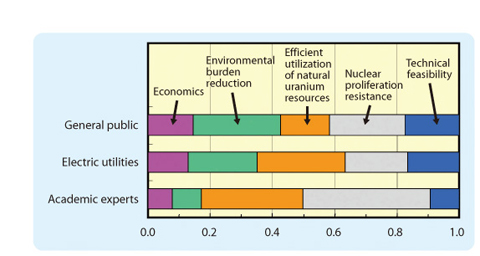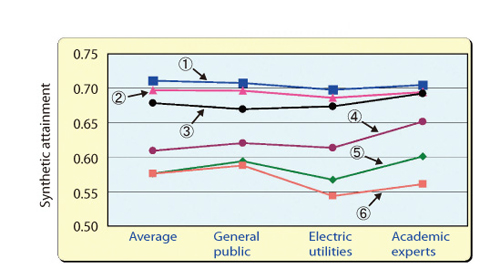
Fig.1-21 FR cycle candidate concepts

Fig.1-22 The weight given to five evaluation viewpoints


Fig.1-23 Multidimensional evaluation of FR cycle candidate concepts by five evaluation viewpoints
Phase II of the Feasibility Study on Commercialized fast reactor (FR) Cycle Systems (FS) was launched in 2001 as a five-year project. As part of the FS, the objective evaluation of multiple aspects of some FR cycle concepts (Fig.1-21) was performed, thus identifying promising FR cycle candidate concepts.
This multidimensional evaluation resulted in the determination of the degree to which the development objectives of the FR cycle system are attained.
We selected 8 evaluation viewpoints for this multidimensional evaluation. With regard to safety, we made pass or fail evaluations since this is considered to be a necessary precondition for the FR cycle. The economics, the environmental burden reduction and the efficient utilization of natural uranium resources were quantitatively evaluated. The nuclear proliferation resistance, the technical feasibility, the business applicability and the public acceptance were evaluated by the combination of the judgment of the academic experts and a quantitative evaluation.
These evaluation viewpoints each have a maximum of four ranks down to a low rating (the hierarchical structure). In the quantitative evaluation, the physical quantity of the lowest rank is converted into a utility value from 0 to 1 using the utility function. All indicators are given appropriate weighting.
We determined the weighting of the evaluation viewpoints based on a questionnaire asking the importance of various considerations for energy in future society, given to the stakeholders, that is, the general public, the electric utilities (the electric power company employees) and the academic experts in the energy field. 5 viewpoints pertinent to energy development were chosen out of 8 possible viewpoints based on these questionnaires. The general public tended to give importance to the environmental burden reduction and the nuclear proliferation resistance, the utility people tended to give importance to the efficient utilization of natural uranium resources, and the academic experts tended to give importance to the efficient utilization of natural uranium resources and the nuclear proliferation resistance (Fig.1-22).
For 5 viewpoints, we calculated the weighting from the results of the questionnaire and calculated the degree to which these viewpoints were satisfied (the sum of all utility values) (Fig.1-23). As a result, it was found that the combination of Sodium cooled FR with MOX fuels, advanced aqueous reprocessing and simplified pelletizing fuel fabrication seems to be satisfy all viewpoints to the highest degree, and is the most promising FR cycle candidate concept.